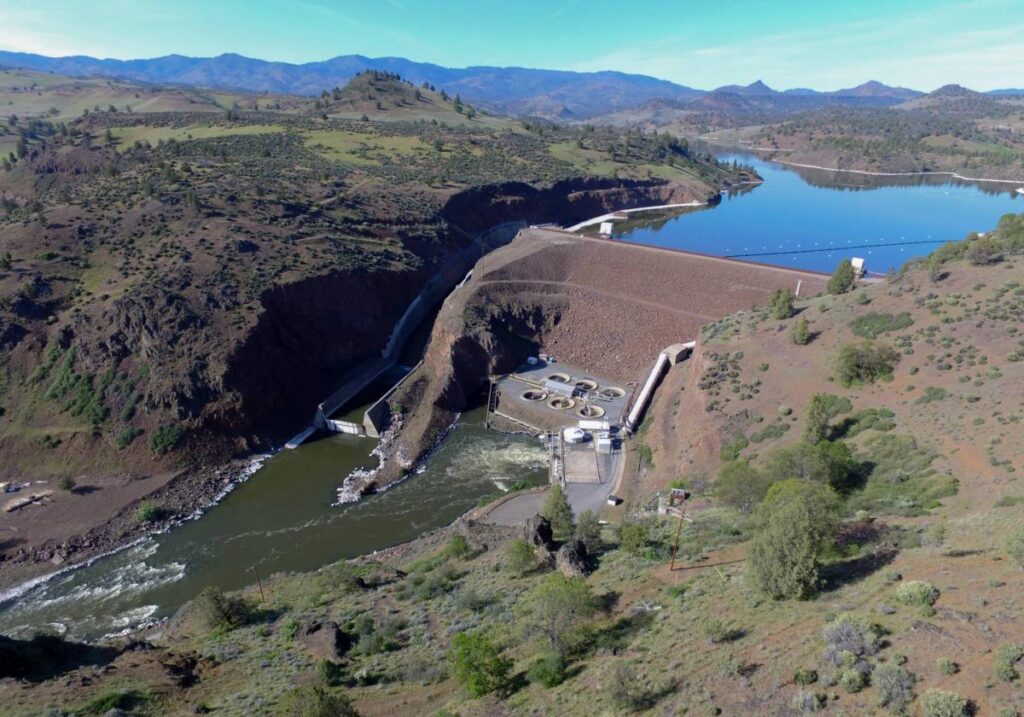Klamath River Renewal Corporation photo
The pre-removal includes demolishing 100,000 cu. yds. of concrete, 1.3 million cu. yds. of excavation, 70,000 cu. yds. of “drill and shoot” and 2,000 tons of steel demolition.
Construction Equipment Guide (CEG) posts thousands of stories each year to our website at www.constructionequipmentguide.com. Here are the most clicked-on stories in 2023 and leading the way is an article that appeared in our Western Edition that garnered an astounding 180,533 pageviews.
Largest Dam Removal in U.S. History Under Way
Construction to start the removal process of the Klamath River dams has begun and all four dams are scheduled to be removed from the river by the end of 2024, according to the latest report from KDRV.
Crews have begun constructing access roads to allow access for heavy equipment required for further construction activities. Existing bridges will need to be reinforced and new bridges will need to be constructed to enable construction equipment access. The Klamath River Renewal Corporation also is in the process of developing several sites to accommodate the workforce, installing job trailers and office space as well as lodging facilities for the construction crews. This is the beginning of a series of enabling construction projects that will take up the remainder of 2023 as crews prepare for drawdown of the reservoirs in January 2024 and the subsequent removal of the dams.
The Federal Energy Regulatory Commission approved this project — the largest dam removal in American history — in November 2022, a project valued at $450 million.
The Klamath River Renewal Corporation (KRRC) is leading the historic construction project. Omaha, Neb.-based Kiewit is the prime contractor on the job while Knight Piesold, headquartered in South Africa, is the civil prime design partner on the project. KRRC took over ownership of the dams from Pacific Power in July 2021. The project is expected to wrap in 2024.
Construction preparation work already is under way at Copco 2.
“That dam and all the facilities associated with Copco 2 at that location should effectively be out of the river no later than September or early October of this year,” said Mark Bransom, CEO of KRRC. “[Current] work includes bridge upgrades, new road construction to access the dam sites more easily, worksite development and more.”
According to the construction overview, crews will begin drilling and blasting operations at Copco 2 to remove it completely. That portion of the project is expected to be completed by this fall. A restored river channel will be built through the existing dam footprint.
Reservoirs behind the existing dams will be simultaneously drawn down over the next several months and other projects will be completed before the dams are removed. According to reports, the pre-removal include demolishing 100,000 cu. yds. of concrete, 1.3 million cu. yds. of excavation, 70,000 cu. yds. of “drill and shoot” and 2,000 tons of steel demolition.
After Copco 2, the J.C. Boyle Dam will be the second dam removed, followed by Copco 1 and then Irongate, according to the schedule. Restoration of the reservoirs and tributaries will begin in early 2024. The four dams have a combined height of 411 ft. Copco 2, which became operational in 1925, is the shortest of the four with a hydraulic height of 27 ft. and structural height of 63 ft.
In total, the four dams impound approximately 15 million cu. yds. of sediment.
KRRC said it is working with experts to monitor potential impacts to the river in the coming years after the removal of four dams.
“We want to wait a little while to allow the river to sort of find its course again,” Bransom said. “Then we’ll come in and add a light touch where it’s appropriate to do so with some restoration that we believe will be beneficial, primarily for habitat and passage conditions for migrating fish.”
One of the goals of removing the dams is to protect the salmon population. KRRC is hopeful that population will return to the river and thrive once again.
“We’re really trying to create conditions that are more favorable than those that exist today to support a more healthy environment for all the communities that rely on the river,” Bransom said.
Northeast Edition
Tobacco Road in Connecticut? Enfield Is Home to One of Oldest, Largest Farms in U.S.
Jarmoc Farms in Enfield, Conn., is one of the oldest and largest continuously operating tobacco farms in the state. It also happens to have a growing fleet of John Deere construction equipment that it uses for the farm operation.
Southeast Edition
Phase Two of $464M LA 1 Bridge Begins in Louisiana
Once this $464 million effort is complete, there will be 19.3 mi. of elevated expressway between Golden Meadow and Port Fourchon. The contract was awarded to Primoris Heavy Civil, James Construction Group LLC (JCG) of Baton Rouge.
Midwest Edition
Kentucky’s Tallest Bridge Under Construction in Pike County
At 324 ft., the twin-span Pond Creek Bridge stands higher than the Statue of Liberty, with workers ever mindful of the steep slopes and county road below.
National Edition
Why Progressive Design-Build Should Be the Project Delivery Method of Choice
In recent years, an alternative project delivery method known as PDB has gained traction as an innovative and effective approach that enhances collaboration between owner, designer, and contractor throughout the project. CEG
Read the full article here

